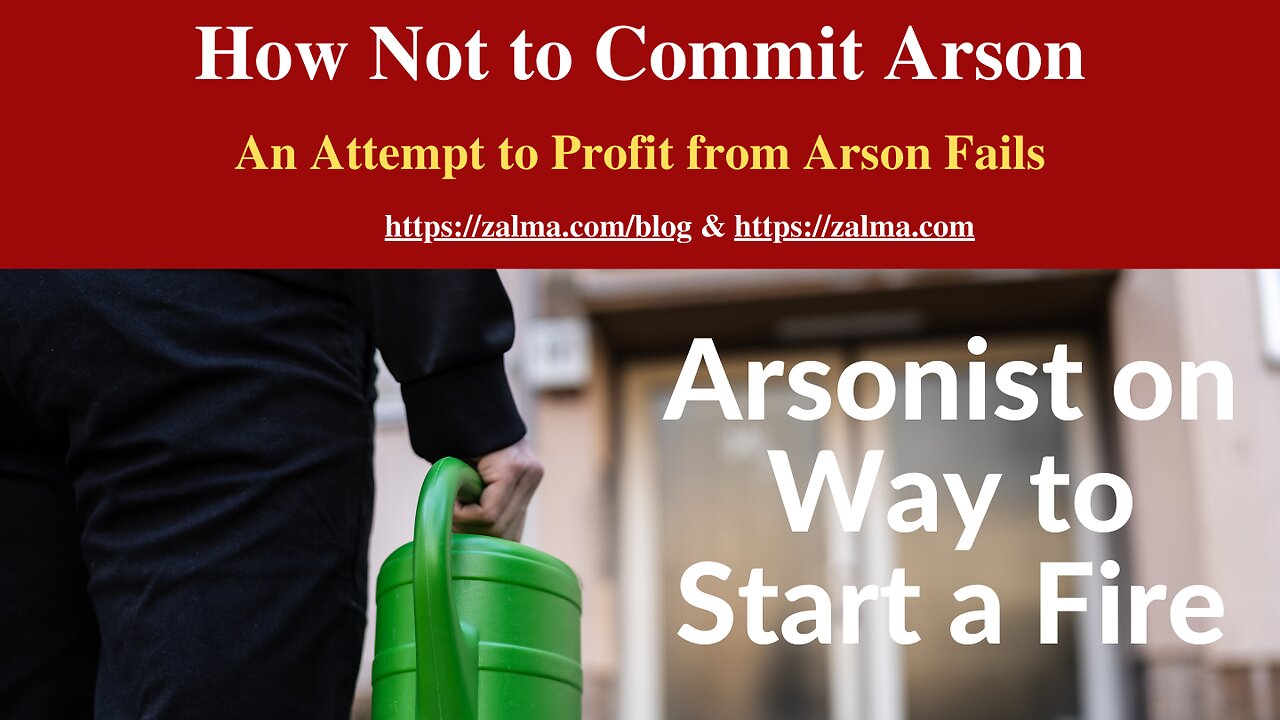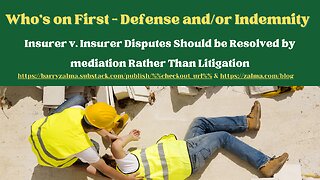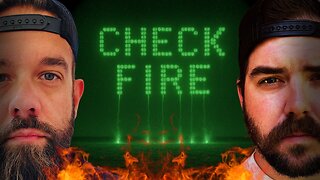Premium Only Content

How Not to Commit Arson
An Attempt to Profit from Arson Fails
See the full video at and at https://youtu.be/xXCaz2ZbuDU
This is a fictionalized true crime story of insurance fraud from an expert who explains why insurance fraud is a “Heads I Win, Tails You Lose” situation for Insurers.
It Takes Skill to use Arson to Defraud an Insurer
Most people do not understand how hard it is to set fire to a house that will destroy the entire dwelling and its contents. Most residences simply do not have sufficient combustibles in the right place to allow for a sustained fire. Many homes, especially the more modern ones, have fail-safe devices everywhere that make accidental fires a thing of the past.
An Insured decided that the only possible means of escaping his mortgage was to burn down his house. Being a rather imaginative fellow, he decided to also make the fire look like an accident.
On leaving his house in the afternoon, he opened the gas jets on the stove, blew out the pilot on his gas dryer and water heater, and set the thermostat on his electronically ignited furnace to 80 degrees Fahrenheit. It was a hot Summer day, but he assumed it would eventually cool off a little, the thermostat would kick on the furnace, and the electronic starter would cause a gas explosion that would destroy the entire house. What he did not count on was Southern California’s Santa Ana Winds that brought heat from the desert and kept the outside temperature in the hundreds all day and into the night. The Insured was shocked that a nosey neighbor with clear sinuses would smell the gas, turn it off at the meter, and save the house.
Of course, when the Insured returned home, he had to hide his disappointment that the house was still there. Undaunted, however, he tried again the next week. This time he took no chances. He went to the hardware store and bought a case of Coleman cooking fuel and spread it throughout the house. Then he tore up a book of paper matches so that there was no cover, only matches. He lit a cigarette and placed it low between the matches and left the house confident that when the cigarette burned down it would ignite the match heads and burn down the house. He was again sorely disappointed when he returned home to find the house still there.
The would-be arsonist had his innocent wife with him as an alibi. When they entered the house, she became hysterical at the sight of the flammable liquids poured throughout the house. She insisted that he report the incident to the fire department. He wouldn’t do it so she, against his wishes, called in the Arson Investigators.
“Boy, you were lucky.” A young fire arson unit investigator said. “The idiot who tried to set fire to your house set his fuse upside down!” Immediately, his partner kicked him in the shins but it was too late to stop him.
The fact that the cigarette, to be used as a fuse, must be placed at the head of the matches, not the base, was not known to the insured and the cigarette merely burned itself out.
The Insured learned a lesson from the arson investigator. The house burned down almost totally two days later.
The claim to the insurer included, among many other things, one encyclopedia Britannica and a wooden duck decoy. These inconsequential items, making up part of a claim for more than $100,000.00 in personal property, led to the Insured’s arrest when they were found, intact and undamaged in his temporary residence.
The Insured was arrested for arson and insurance fraud. His claim was denied.
He, of course, sued for bad faith, and the insurer was required to defend the law suit for a total of five years because it could not compel his testimony at deposition or trial until his criminal case was resolved. In the fifth year of the bad faith suit the insured’s lawyer called the insurer’s lawyer and suggested his client would provide a release and dismiss the suit with prejudice for a payment of only $5,000. The adjuster in charge – although he had spent over $30,000 defending the suit, refused the settlement and instructed his lawyer to offer only $2,000.
Following instructions, the insulting offer was made and, much to the surprise of the defense lawyer, the offer was accepted. The suit finally settled with the arsonist and his presumably innocent spouse, for a payment of $2,000.00. Twenty times less than that amount expended by the insurer to defend the spurious lawsuit brought by the Insured.
Why did the Insured offer to settle for so little? For at least two reasons:
Because the District Attorney could not set a man free to try the arson case and it was continued over and over again until all the witnesses were gone or had forgotten everything they knew.
Because the District Attorney and the Insured had made a deal that if the Insured pleaded guilty to one count of insurance fraud he would not go to jail.
The District Attorney, although he knew of the insurer’s interest in the case and the lawsuit pending against it did not advise the insurer of the deal. Of course, had the insurer known that the insured was going to plead guilty to insurance fraud they would have paid nothing.
The case was never tried. Two days after the settlement was paid in the civil action and more than five years after the fire, the Insured appeared in criminal court and pleaded guilty to one count of insurance fraud. He was given probation. The case wasn’t a priority matter to the prosecutor since only an insurance company was being hurt. The fact that the insurer was required to defend a bad faith suit for five years at enormous cost was of no apparent concern to the prosecutors.
The Insured did not profit from the fire with a cash award. He was relieved of his mortgage debt [which the insurer was required to pay to the mortgagee who had not been culpable in the arson] and he paid his lawyer one third of the $2,000 settlement. Since the insured was judgment proof the insurer lost, as uncollectable, the amount paid to the mortgagee and sold the bare land.
Interestingly, the arson investigator who worked so hard to find evidence to arrest the insured was later arrested and convicted as a serial arsonist. Apparently, he was upset that there was an arson fire in his town that he did not set.
Adapted from my book Insurance Fraud Costs Everyone
(c) 2023 Barry Zalma & ClaimSchool, Inc.
Subscribe and receive videos limited to subscribers of Excellence in Claims Handling at locals.com https://zalmaoninsurance.locals.com/subscribe.
Consider subscribing to my publications at substack at https://barryzalma.substack.com/publish/post/107007808
Go to Newsbreak.com https://www.newsbreak.com/@c/1653419?s=01
Barry Zalma, Esq., CFE, is available at http://www.zalma.com and [email protected]
Follow me on LinkedIn: www.linkedin.com/comm/mynetwork/discovery-see-all?usecase=PEOPLE_FOLLOWS&followMember=barry-zalma-esq-cfe-a6b5257
Write to Mr. Zalma at [email protected]; http://www.zalma.com; http://zalma.com/blog; daily articles are published at https://zalma.substack.com. Go to the podcast Zalma On Insurance at https://podcasters.spotify.com/pod/show/barry-zalma/support; Follow Mr. Zalma on Twitter at https://twitter.com/bzalma; Go to Barry Zalma videos at Rumble.com at https://rumble.com/c/c-262921; Go to Barry Zalma on YouTube- https://www.youtube.com/channel/UCysiZklEtxZsSF9DfC0Expg; https://creators.newsbreak.com/home/content/post; Go to the Insurance Claims Library – https://zalma.com/blog/insurance-claims-library.
-
 10:17
10:17
Barry Zalma, Inc. on Insurance Law
1 year agoWho's on First - Defense and/or Indemnity
198 -
 19:01
19:01
Stephen Gardner
10 hours agoAlex Jones: ‘Trump Is About to Do Something MASSIVE!'
35.2K118 -
 5:14:39
5:14:39
Drew Hernandez
1 day agoCANDACE OWENS ACCEPTS TPUSA INVITATION TO DISCUSS SUSPICION BEHIND CHARLIE KIRK ASSASSINATION?!
35.3K17 -
 2:52:10
2:52:10
TimcastIRL
6 hours agoDrunk Raccoon Becomes Top US Story After Getting Plastered, Passing Out In Bathroom | Timcast IRL
220K101 -
 7:15:08
7:15:08
SpartakusLIVE
9 hours agoRule #1 - The BEST Loot is ALWAYS in the OTHER GUY'S BAG
37.9K -
 2:16:27
2:16:27
ThatStarWarsGirl
6 hours agoTSWG LIVE: CHRISTMAS IS COMING! Stargate's BACK & DC is Doomed?!
22.8K4 -
 2:38:16
2:38:16
I_Came_With_Fire_Podcast
14 hours agoDid Pete Hegseth Commit WAR CRIMES | No more INCOME TAX | More Fraud in Minnesota W/ Mike Caldarisie
28.5K13 -
 1:32:30
1:32:30
Adam Does Movies
9 hours ago $1.25 earnedTalking Movies + Ask Me Anything - LIVE
21.8K1 -
 2:12:14
2:12:14
TheSaltyCracker
6 hours agoWar Crimes ReeEEStream 12-03-25
77.7K191 -
 1:31:59
1:31:59
Glenn Greenwald
8 hours agoTrump Administration Claims to Save Hundreds of Millions of Lives by Blowing Up Drug Boats; Ethan Klein's Unhinged Vengeance & Lawsuits Against Other YouTubers: With Taylor Lorenz | SYSTEM UPDATE #553
107K151